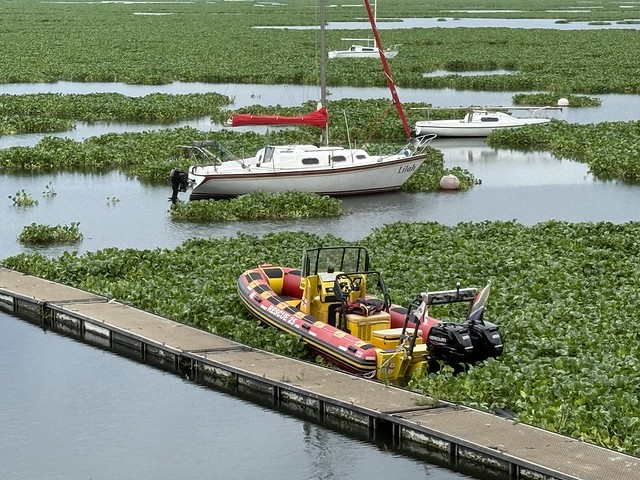By Staff Reporter
The National Sea Rescue Institute (NSRI) has told the public to think twice before launching boats or other craft onto Hartbeespoort Dam, saying that fast-spreading water hyacinth is creating dangerous conditions and complicating rescue operations.
The NSRI said on Monday that a floating mass of water hyacinth currently covers large areas of the dam and is expected to increase rapidly in the coming weeks as summer growth accelerates.
Changes in wind direction are driving thick mats of the invasive weed swiftly and unpredictably across the water, creating hazardous conditions for watercraft.
“We are asking the public to carefully consider whether it is safe to go out on the water,” said Arthur Crewe, NSRI Hartbeespoort Station Commander.
“If your craft becomes trapped in the hyacinth, the rescue options are limited. Even our rescue vessels suffer damage attempting to get through, and in some cases, rescues are extremely challenging.”
The NSRI said that boat engines may overheat or break down as vegetation and submerged debris tangle propellers. Sudden wind shifts can also push the hyacinth mass across the dam, cutting off previously clear routes.
Water hyacinth, a free-floating plant native to the Amazon Basin in South America, was introduced into South Africa as an ornamental in the early 1900s and has become the country’s most problematic aquatic weed.
Hartbeespoort Dam, which receives nutrient-rich inflows from sewage works, informal settlements and agricultural runoff upstream of Pretoria and Johannesburg, provides ideal conditions for the plant to thrive in summer, forming dense mats that block sunlight, deplete oxygen and have contributed to fish kills.
A variety of methods have been tried to curb the hyacinth, including herbicide spraying and mechanical removal, but in recent years the shift has been to biological control.
Nearly half a million water hyacinth planthoppers (Megamelus scutellaris) and other insects were released between 2018 and 2023 on Hartbeespoort as part of a community-based programme to weaken the weed, but recurring nutrient pollution and a long-lived seed bank mean infestations continue to re-emerge.
NSRI crews remain on standby for life-threatening emergencies but said that the public should not underestimate the risks.
“Launching without a clear understanding of where the hyacinth is, and how fast it’s moving, places not only your life at risk but also that of our volunteers,” said Crewe.
“Every rescue in these conditions is dangerous and may result in further damage to rescue equipment and delays in assistance.”
The NSRI advised boaters who go out despite its warning to study the latest weather and wind forecasts, monitor the movement of the hyacinth mass before and during trips, and inform someone on shore of their exact route and planned return time.
Skippers should carry enough provisions and exposure protection to remain on board for an extended period if trapped, said the NSRI.
“Always wear lifejackets, keep a charged cellphone in a waterproof pouch and use the NSRI SafeTRX app to log [your] voyage,” the organisation said.
INSIDE METROS

